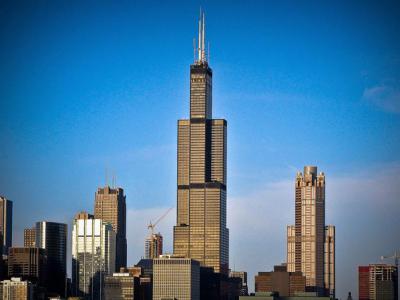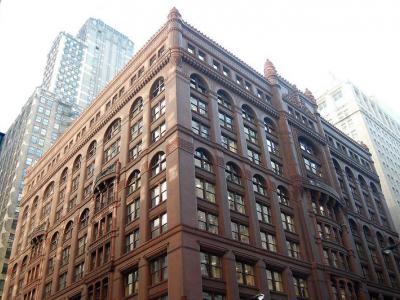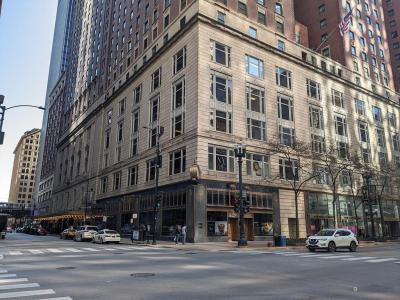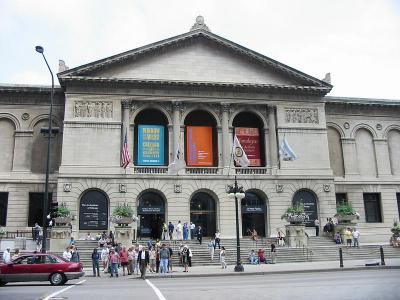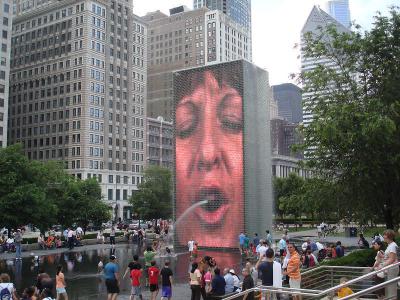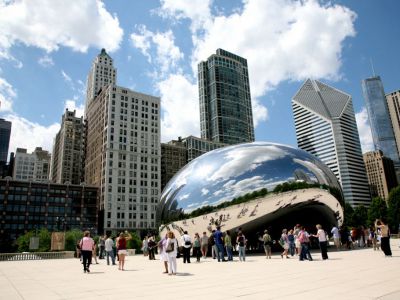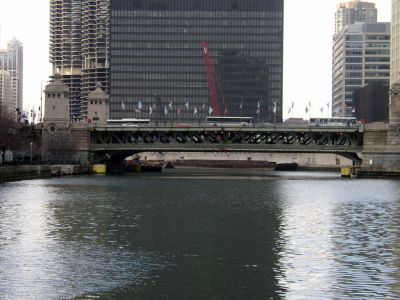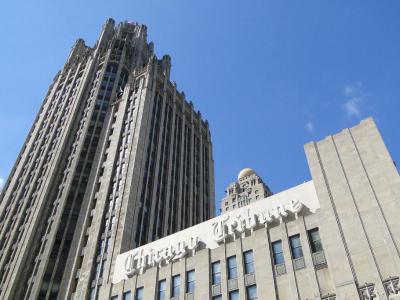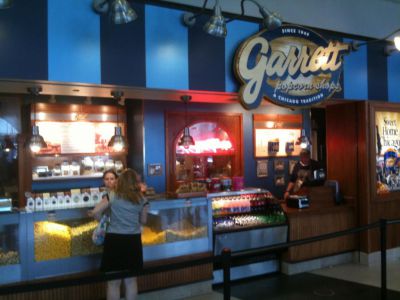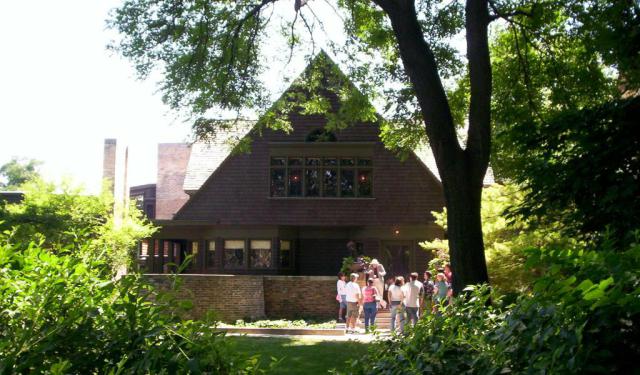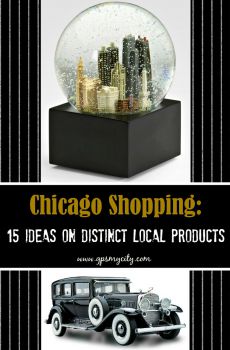
Chicago Introduction Walking Tour (Self Guided), Chicago
Chicago, perched on the shores of Lake Michigan in Illinois, is a city steeped in history and urban vibrancy. Known by numerous nicknames such as the Windy City and the City of Big Shoulders, it boasts a skyline marked by towering structures. The area of today's Chicago, initially inhabited by Native American tribes, saw its first European-settled reference as "Chicagou" in 1679, a name derived from the indigenous Algonquian word for wild garlic, "shikaakwa," that once grew here in large quantities. Jean Baptiste Point du Sable, regarded as Chicago’s founder, was the first non-indigenous settler in the late 18th century.
Chicago’s incorporation in 1837 marked the beginning of rapid growth, establishing itself as a crucial transportation hub in the US. The city’s expansion continued through the 1920s, drawing migrants for industrial jobs and gaining notoriety during Prohibition with figures like Al Capone. Post-Great Depression, World War II fueled a resurgence in industries, drawing a significant influx of African Americans from the South for manufacturing jobs.
The city is a pioneer in urban planning and architecture, contributing styles such as the Chicago School and steel-framed skyscrapers. It remains a bustling hub for international trade and commerce, with its tourist attractions earning it a spot among the top US cities to visit. Noteworthy landmarks include Millennium Park, known for its Cloud Gate sculpture and Crown Fountain, and the Willis Tower, one of the tallest buildings in the world.
Architectural exploration begins at the Palmer House, a historic hotel from the 19th century, perfectly located to explore the city’s core. Nearby, Wrigley Square’s Millennium Monument, a tribute to the original peristyle of 1917, offers a tranquil escape. Further exploration leads to the Wrigley Building, a beacon of Chicago’s innovative spirit, and the Tribune Tower, which incorporates stones from global landmarks into its Neo-Gothic design.
Culinary adventures are a must in Chicago. Starting at Palmer House, the birthplace of Brownie – one of America's most-loved desserts, proceed to Garrett Popcorn Shops, where the scent of their famed Chicago Mix popcorn is irresistible. Another culinary highlight is Pizzeria Uno, the cradle of Chicago-style deep-dish pizza, offering a taste of local tradition through its indulgent "pies".
Chicago’s essence is a blend of monumental architecture and Midwestern charm, inviting visitors to delve into its history, architecture, and gastronomy. Each site and flavor tells part of the grand story of this dynamic American city, making it an essential experience for travelers. For those eager to immerse themselves fully, this self-guided walk through the city’s prominent attractions is highly recommended.
Chicago’s incorporation in 1837 marked the beginning of rapid growth, establishing itself as a crucial transportation hub in the US. The city’s expansion continued through the 1920s, drawing migrants for industrial jobs and gaining notoriety during Prohibition with figures like Al Capone. Post-Great Depression, World War II fueled a resurgence in industries, drawing a significant influx of African Americans from the South for manufacturing jobs.
The city is a pioneer in urban planning and architecture, contributing styles such as the Chicago School and steel-framed skyscrapers. It remains a bustling hub for international trade and commerce, with its tourist attractions earning it a spot among the top US cities to visit. Noteworthy landmarks include Millennium Park, known for its Cloud Gate sculpture and Crown Fountain, and the Willis Tower, one of the tallest buildings in the world.
Architectural exploration begins at the Palmer House, a historic hotel from the 19th century, perfectly located to explore the city’s core. Nearby, Wrigley Square’s Millennium Monument, a tribute to the original peristyle of 1917, offers a tranquil escape. Further exploration leads to the Wrigley Building, a beacon of Chicago’s innovative spirit, and the Tribune Tower, which incorporates stones from global landmarks into its Neo-Gothic design.
Culinary adventures are a must in Chicago. Starting at Palmer House, the birthplace of Brownie – one of America's most-loved desserts, proceed to Garrett Popcorn Shops, where the scent of their famed Chicago Mix popcorn is irresistible. Another culinary highlight is Pizzeria Uno, the cradle of Chicago-style deep-dish pizza, offering a taste of local tradition through its indulgent "pies".
Chicago’s essence is a blend of monumental architecture and Midwestern charm, inviting visitors to delve into its history, architecture, and gastronomy. Each site and flavor tells part of the grand story of this dynamic American city, making it an essential experience for travelers. For those eager to immerse themselves fully, this self-guided walk through the city’s prominent attractions is highly recommended.
How it works: Download the app "GPSmyCity: Walks in 1K+ Cities" from Apple App Store or Google Play Store to your mobile phone or tablet. The app turns your mobile device into a personal tour guide and its built-in GPS navigation functions guide you from one tour stop to next. The app works offline, so no data plan is needed when traveling abroad.
Chicago Introduction Walking Tour Map
Guide Name: Chicago Introduction Walking Tour
Guide Location: USA » Chicago (See other walking tours in Chicago)
Guide Type: Self-guided Walking Tour (Sightseeing)
# of Attractions: 12
Tour Duration: 2 Hour(s)
Travel Distance: 3.9 Km or 2.4 Miles
Author: doris
Sight(s) Featured in This Guide:
Guide Location: USA » Chicago (See other walking tours in Chicago)
Guide Type: Self-guided Walking Tour (Sightseeing)
# of Attractions: 12
Tour Duration: 2 Hour(s)
Travel Distance: 3.9 Km or 2.4 Miles
Author: doris
Sight(s) Featured in This Guide:
- Willis Tower - Skydeck Chicago
- Rookery Building
- Palmer House
- Art Institute of Chicago
- Crown Fountain
- Cloud Gate
- Wrigley Square and Millennium Monument
- DuSable Bridge
- Wrigley Building
- Tribune Tower
- Garrett Popcorn
- Pizzeria Uno
1) Willis Tower - Skydeck Chicago (must see)
While London and Paris are recognized respectively for their Big Ben and Eiffel Tower, Chicago has its own architectural landmark that makes its skyline unmistakable for any other place – the Willis Tower. Designed by Skidmore, Owings & Merrill in 1974 and formerly known as the Sears Tower, the building once stood as the tallest skyscraper in the world, until 1996. Recommended by the readers of the Chicago Tribune as one of the "7 wonders of Chicago", this impressive structure rises 1,730 feet tall, spanning 110 stories. While it may have yielded its title and embraced a new name, the fascination of the Skydeck on the 103rd floor remains unmatched. On clear days, it provides breathtaking vistas encompassing the states of Illinois, Michigan, Wisconsin, and Indiana.
The journey in the elevator, lasting a mere 70 seconds, is transformed into an exhilarating experience through video monitors. Within the observatory, interactive exhibits breathe life into Chicago's visionaries, entrepreneurs, architects, musicians, and sports icons. Additionally, computer kiosks, available in six languages, aid international travelers in discovering Chicago's most sought-after destinations. Yet, for many visitors, the ultimate highlight is stepping onto the Ledge, a glass enclosure protruding 4.3 feet from the building, creating the illusion of being suspended 1,353 feet above the ground.
Despite occupying an entire city block and boasting over four million square feet of interior space, the tower was remarkably constructed in just three years. Its innovative design featured nine massive steel "tubes" of varying lengths, bundled together to provide both strength and flexibility. The concept for these distinct levels is said to have originated from the observation of someone shaking cigarettes out of a pack. Initially intended to accommodate up to 13,000 employees of the department store Sears Roebuck & Co., the tower changed hands in 1989 when it was sold to three property developers and is now home to a diverse range of commercial tenants. Remarkably, it houses one hundred elevators and 16,000 windows, all of which are thankfully equipped with automatic window-cleaning systems.
Tip:
Before deciding to ascend, it is advisable to check the visibility ratings, either on your phone or at the security desk. If visibility is less than five miles, it's best to plan your visit for another time.
The journey in the elevator, lasting a mere 70 seconds, is transformed into an exhilarating experience through video monitors. Within the observatory, interactive exhibits breathe life into Chicago's visionaries, entrepreneurs, architects, musicians, and sports icons. Additionally, computer kiosks, available in six languages, aid international travelers in discovering Chicago's most sought-after destinations. Yet, for many visitors, the ultimate highlight is stepping onto the Ledge, a glass enclosure protruding 4.3 feet from the building, creating the illusion of being suspended 1,353 feet above the ground.
Despite occupying an entire city block and boasting over four million square feet of interior space, the tower was remarkably constructed in just three years. Its innovative design featured nine massive steel "tubes" of varying lengths, bundled together to provide both strength and flexibility. The concept for these distinct levels is said to have originated from the observation of someone shaking cigarettes out of a pack. Initially intended to accommodate up to 13,000 employees of the department store Sears Roebuck & Co., the tower changed hands in 1989 when it was sold to three property developers and is now home to a diverse range of commercial tenants. Remarkably, it houses one hundred elevators and 16,000 windows, all of which are thankfully equipped with automatic window-cleaning systems.
Tip:
Before deciding to ascend, it is advisable to check the visibility ratings, either on your phone or at the security desk. If visibility is less than five miles, it's best to plan your visit for another time.
2) Rookery Building
The Rookery Building is a cornerstone of Chicago's rich architectural heritage, showcasing the work of the city's two great design architects, John Wellborn Root and Frank Lloyd Wright. The building was designated a Chicago Landmark in 1972 and was added to the list of National Historic Landmarks in 1975.
After the Great Chicago Fire of 1871, a temporary city hall was built at the corner of LaSalle and Adams Streets around a water storage tank. The tank was a hangout for crows, and the locals called it "the Rookery." This was a reference to the birds and also a reference to corrupt politicians in the building.
In 1888, architects Daniel Burnham and John Wellborn Root completed their 11-story commercial building at the Rookery site and named it "Rookery." John Wellborn Root carved a pair of rooks into the Romanesque main entrance on La Salle Street.
The Rookery was truly transitional, with elevators, fireproofing, and electric lighting. John W. Root planned to have as much natural light in the building as possible. He developed a hollow square plan. Offices in the building would be lighted from the outside or the central two-story light court with its glass-paneled ceiling and grand staircases.
In 1905, Burnham commissioned Frank Lloyd Wright to renovate the interiors, especially the "light court." Wright removed Root's ironwork and replaced it with Carrara marble incised with gilded arabesque designs. The Rookery became a white and gold commercial center.
The double set of ornate stairs winds upward. A wrap-around balcony climbing up to the second floor creates the sense of "clockwork." The facade of the Rookery is of marble, terra cotta, and brick. The overall style is Romanesque, featuring touches of Roman Revival and Queen Anne. A second renovation in 1931 included Art Deco details.
The Frank Lloyd Wright Trust conducts tours Mondays through Fridays. Inside Chicago has daily walking tours of the Rookery. The Rookery has been a locale for films such as Home Alone 2 and The Untouchables.
After the Great Chicago Fire of 1871, a temporary city hall was built at the corner of LaSalle and Adams Streets around a water storage tank. The tank was a hangout for crows, and the locals called it "the Rookery." This was a reference to the birds and also a reference to corrupt politicians in the building.
In 1888, architects Daniel Burnham and John Wellborn Root completed their 11-story commercial building at the Rookery site and named it "Rookery." John Wellborn Root carved a pair of rooks into the Romanesque main entrance on La Salle Street.
The Rookery was truly transitional, with elevators, fireproofing, and electric lighting. John W. Root planned to have as much natural light in the building as possible. He developed a hollow square plan. Offices in the building would be lighted from the outside or the central two-story light court with its glass-paneled ceiling and grand staircases.
In 1905, Burnham commissioned Frank Lloyd Wright to renovate the interiors, especially the "light court." Wright removed Root's ironwork and replaced it with Carrara marble incised with gilded arabesque designs. The Rookery became a white and gold commercial center.
The double set of ornate stairs winds upward. A wrap-around balcony climbing up to the second floor creates the sense of "clockwork." The facade of the Rookery is of marble, terra cotta, and brick. The overall style is Romanesque, featuring touches of Roman Revival and Queen Anne. A second renovation in 1931 included Art Deco details.
The Frank Lloyd Wright Trust conducts tours Mondays through Fridays. Inside Chicago has daily walking tours of the Rookery. The Rookery has been a locale for films such as Home Alone 2 and The Untouchables.
3) Palmer House
Claimed to be the longest-running hotel in Chicago, Palmer House is known for its historical innovations. It was the first hotel in the city to use the light bulb, telephone, and elevator. Over the years, Palmer House has hosted a number of prominent individuals such as US presidents and literary giants like Charles Dickens and Oscar Wilde.
Still, the hotel's most lasting contribution to the country's heritage is one of America's most-loved desserts. Brownie was invented here.
In 1893, Bertha Palmer, the hotel's owner, asked her pastry chef to prepare a dessert to be included in the boxed lunches for ladies attending the Chicago World's Columbian Exposition. Requesting a cake-like confection, she thus gave rise to the Palmer House Brownie – a dense, chocolatey treat with a walnut and apricot glaze.
This dessert gained popularity and was first referred to as "brownie" in the Sears Roebuck Catalog in 1898. Now over a century old, its original recipe is still used for the brownie served at the Palmer House. The hotel's guests and visitors can purchase the authentic Palmer House Brownie at the on-site restaurant Lockwood Express.
Still, the hotel's most lasting contribution to the country's heritage is one of America's most-loved desserts. Brownie was invented here.
In 1893, Bertha Palmer, the hotel's owner, asked her pastry chef to prepare a dessert to be included in the boxed lunches for ladies attending the Chicago World's Columbian Exposition. Requesting a cake-like confection, she thus gave rise to the Palmer House Brownie – a dense, chocolatey treat with a walnut and apricot glaze.
This dessert gained popularity and was first referred to as "brownie" in the Sears Roebuck Catalog in 1898. Now over a century old, its original recipe is still used for the brownie served at the Palmer House. The hotel's guests and visitors can purchase the authentic Palmer House Brownie at the on-site restaurant Lockwood Express.
4) Art Institute of Chicago (must see)
Perched atop a grand set of stone steps and guarded by its iconic lion statues, you'll discover the Midwest's most extensive art museum. Within the colossal Beaux-Arts structure, this institution proudly displays an expansive array of artworks from diverse regions worldwide. It is notably enhanced by a comprehensive assortment of modern and contemporary pieces featured in the Modern Wing, an architectural marvel designed by the renowned Italian architect, Renzo Piano.
Organized chronologically, the extensive European Collection spans from the Middle Ages to 1950, encompassing a substantial assortment of Renaissance and Baroque art and sculptures. Yet, its primary attraction lies in its nearly 400 Impressionist and Post-Impressionist paintings. Meanwhile, the American Arts collection comprises approximately 5,500 paintings and sculptures spanning from the 1600s to 1950. Additionally, the loans from the Terra Foundation collection encompass paintings and works on paper, as well as a diverse range of decorative arts, including furniture, glass, and ceramics from the 18th century to the present (notably, the silver collection stands out). Among the must-see attractions are beloved Chicago gems such as the Thorne Miniature Room and Chagall's remarkable stained-glass creation, "American Windows".
Why You Should Visit:
The diverse collection encompasses paintings, drawings, sculptures, and designs that span from ancient times to the contemporary world. Visitors will have the opportunity to explore a rich array of artworks from various eras and regions, including Greek, Roman, Byzantine, European, Asian, African, and Native American art. Additionally, you can delve into the museum's extensive and comprehensive photography collection, making it a truly enriching cultural experience.
Organized chronologically, the extensive European Collection spans from the Middle Ages to 1950, encompassing a substantial assortment of Renaissance and Baroque art and sculptures. Yet, its primary attraction lies in its nearly 400 Impressionist and Post-Impressionist paintings. Meanwhile, the American Arts collection comprises approximately 5,500 paintings and sculptures spanning from the 1600s to 1950. Additionally, the loans from the Terra Foundation collection encompass paintings and works on paper, as well as a diverse range of decorative arts, including furniture, glass, and ceramics from the 18th century to the present (notably, the silver collection stands out). Among the must-see attractions are beloved Chicago gems such as the Thorne Miniature Room and Chagall's remarkable stained-glass creation, "American Windows".
Why You Should Visit:
The diverse collection encompasses paintings, drawings, sculptures, and designs that span from ancient times to the contemporary world. Visitors will have the opportunity to explore a rich array of artworks from various eras and regions, including Greek, Roman, Byzantine, European, Asian, African, and Native American art. Additionally, you can delve into the museum's extensive and comprehensive photography collection, making it a truly enriching cultural experience.
5) Crown Fountain
To the south of Tribune Plaza, you'll encounter Crown Fountain, a striking installation designed by the renowned Spanish architect Jaume Plensa. Comprising two impressive 50-foot (15.2-meter) glass towers that face each other across a granite plaza, this fountain is a unique attraction. Beneath the surface of the glass blocks, LED screens display a rotating gallery of close-up images featuring 1,000 Chicago residents. These individuals, drawn from various communities within the city, were asked to simulate blowing on a feather while being filmed. Now, when their digital representations purse their lips, water playfully spouts from their mouths, bringing joy to playful children. In the summertime, it transforms into a popular splash park, but even during Chicago's winters, the fountain retains its lifelike charm.
The atmosphere surrounding Crown Fountain is infectious, drawing people from diverse backgrounds and fostering an extraordinary sense of community. It's the kind of place that transcends social boundaries and unites people, if only for a brief moment. The sight of strangers-turned-friends sharing laughter as they dodge the dancing water spouts is bound to bring a smile to your face.
Why You Should Visit:
Whether you want to bask in the sun, enjoy a picnic, or simply take a leisurely stroll, everything is readily available here. The area is consistently well-maintained, with crystal-clear water and meticulously kept grounds. It's evident that the city takes great pride in preserving the beauty of this location, and this commitment shines through in every aspect.
The atmosphere surrounding Crown Fountain is infectious, drawing people from diverse backgrounds and fostering an extraordinary sense of community. It's the kind of place that transcends social boundaries and unites people, if only for a brief moment. The sight of strangers-turned-friends sharing laughter as they dodge the dancing water spouts is bound to bring a smile to your face.
Why You Should Visit:
Whether you want to bask in the sun, enjoy a picnic, or simply take a leisurely stroll, everything is readily available here. The area is consistently well-maintained, with crystal-clear water and meticulously kept grounds. It's evident that the city takes great pride in preserving the beauty of this location, and this commitment shines through in every aspect.
6) Cloud Gate (must see)
Situated at the heart of AT&T Plaza within Millennium Park, Cloud Gate was created during the years 2004 to 2006, under the artistic vision of Anish Kapoor, an Indian-born British sculptor renowned for his large-scale outdoor artworks, many of which feature highly reflective surfaces. This sculpture marked Kapoor's inaugural foray into public outdoor art in the U.S., standing as his most iconic creation.
Crafted entirely from stainless steel, this monumental work meticulously joined 168 plates, expertly polished to conceal any visible seams. Towering over three stories tall, it spans 66 feet in length, 33 in height, and 42 in width, with a weight of 100 tons. Locals affectionately refer to it as "The Bean", though its design was actually inspired by the shape of a mercury droplet. With its concave underside, it conjures a funhouse mirror effect for those who venture beneath, reflecting captivatingly distorted images of the Chicago skyline.
Before its installation, Cloud Gate stirred controversy among experts, some of whom doubted its feasibility due to the technical challenges related to construction, assembly, maintenance, and upkeep. While a viable solution was eventually devised, the project experienced delays and was still unfinished when Millennium Park opened in 2004. The formal dedication of Cloud Gate took place on May 15, 2006, following its completion, and it has since garnered widespread acclaim both domestically and internationally.
Why You Should Visit:
Taking a selfie in front of this captivating artwork, which mirrors the surrounding skyline, has become an iconic Chicago souvenir.
Crafted entirely from stainless steel, this monumental work meticulously joined 168 plates, expertly polished to conceal any visible seams. Towering over three stories tall, it spans 66 feet in length, 33 in height, and 42 in width, with a weight of 100 tons. Locals affectionately refer to it as "The Bean", though its design was actually inspired by the shape of a mercury droplet. With its concave underside, it conjures a funhouse mirror effect for those who venture beneath, reflecting captivatingly distorted images of the Chicago skyline.
Before its installation, Cloud Gate stirred controversy among experts, some of whom doubted its feasibility due to the technical challenges related to construction, assembly, maintenance, and upkeep. While a viable solution was eventually devised, the project experienced delays and was still unfinished when Millennium Park opened in 2004. The formal dedication of Cloud Gate took place on May 15, 2006, following its completion, and it has since garnered widespread acclaim both domestically and internationally.
Why You Should Visit:
Taking a selfie in front of this captivating artwork, which mirrors the surrounding skyline, has become an iconic Chicago souvenir.
7) Wrigley Square and Millennium Monument
Nestled on the corner of Michigan Avenue and Randolph Street, in the northwest part of Chicago's Millennium Park, Wrigley Square is a tree-lined, public area serving as an outdoor exhibit and performance space. Inviting to those who seek relaxation amid its large lawn, fountain, and stroll paths, this square also has a reputation as a vibrant place for cultural events such as art shows, photography displays, and occasional live music performances.
Anchoring the square is the Millennium Monument, a nearly full-sized replica of the original peristyle that once stood in this section of Grant Park, from 1917 until 1953 (when it was dismantled to make room for a parking lot). With its graceful semi-circular row of 40-foot Doric-style limestone columns, this monument elegantly contributes to the Michigan Avenue designation as a landmark district.
Etched in stone on the monument's base are the names of 122 founders of Millennium Park – private and corporate donors, who supported its design, construction, and ongoing art and architecture curation. In 2017, the structure was artistically enhanced with LED color-changing lighting, new pre-cast concrete elements, and new pavers for the fountain plaza at its base.
Anchoring the square is the Millennium Monument, a nearly full-sized replica of the original peristyle that once stood in this section of Grant Park, from 1917 until 1953 (when it was dismantled to make room for a parking lot). With its graceful semi-circular row of 40-foot Doric-style limestone columns, this monument elegantly contributes to the Michigan Avenue designation as a landmark district.
Etched in stone on the monument's base are the names of 122 founders of Millennium Park – private and corporate donors, who supported its design, construction, and ongoing art and architecture curation. In 2017, the structure was artistically enhanced with LED color-changing lighting, new pre-cast concrete elements, and new pavers for the fountain plaza at its base.
8) DuSable Bridge
Chicago boasts one of the largest collections of movable bridges in the world, with trunnion bascules being the predominant type. This particular bridge, well-suited for its prominent and bustling location, elegantly spans the river without any protruding superstructures, maintaining a generous, navigable channel. Its construction held paramount importance in the 1909 Plan of Chicago, serving as a catalyst for the rapid revitalization of real estate along North Michigan Avenue. Drawing inspiration from the design of Paris's Alexander III Bridge (1900), it features four corner pylons, decorative abutments, a gracefully flat arch profile, and seamlessly integrated embankments.
The forty-foot pylons, serving as functional operator houses, are adorned with sculptural reliefs narrating key events in Chicago's history. These include the explorations of Marquette and Joliet, the establishment of the city by trader Jean Baptiste Point du Sable, the Fort Dearborn Massacre of 1812, and the city's reconstruction following the devastating Great Chicago Fire of 1871. A commemorative plaque marks the site of the fort at the southern end of the bridge. Additionally, the southwest structure now houses a museum operated by the Friends of the Chicago River, open seasonally, providing visitors with the opportunity to observe the inner workings of the bridge's gears responsible for its opening and closing.
The forty-foot pylons, serving as functional operator houses, are adorned with sculptural reliefs narrating key events in Chicago's history. These include the explorations of Marquette and Joliet, the establishment of the city by trader Jean Baptiste Point du Sable, the Fort Dearborn Massacre of 1812, and the city's reconstruction following the devastating Great Chicago Fire of 1871. A commemorative plaque marks the site of the fort at the southern end of the bridge. Additionally, the southwest structure now houses a museum operated by the Friends of the Chicago River, open seasonally, providing visitors with the opportunity to observe the inner workings of the bridge's gears responsible for its opening and closing.
9) Wrigley Building
Perched along the river, at the bend of Michigan Avenue, is the Wrigley Building, a towering symbol of old Chicago deeply ingrained in the hearts of locals. Renowned for its radiant white exterior, this "Jewel of the Mile" stands majestically, with its grandeur enhanced by the mirrored image in the water when looked at from either the east or west sides.
Yet, the Wrigley Building is more than just a beloved symbol; it encapsulates the essence of Chicago's architectural history up to the 1920s. Designed by the talented young architect Charles Gerhard Beersman, the structure's tripartite division draws inspiration from European traditions, a common practice among Chicago's commercial architects since the city's rebirth following the 1871 fire. Beersman was inspired by the dazzling effects of the 1893 White City designs in Chicago, leading him to embellish the building with sparkling terra-cotta cladding.
He selected six shades of tiles, ranging from creamy white, at the base, to blue-white, at the summit, creating an ascending brilliance. When the night falls, an array of floodlights on adjacent structures bathes the Wrigley Building in a captivating, ever-intensifying luminance. Whether it's noon or midnight, the edifice stands as a brilliant beacon against the sky.
Just next door, at 401 North Wabash Avenue, the mirrored oval Trump International Hotel & Tower reached its peak in September 2008; soaring to 92 stories, it was briefly the second-tallest building in the United States, after the Sears Tower. Initially, Donald Trump had ambitious plans to make it the world's tallest building, but these were scaled back in the aftermath of the September 11 attacks. Impressively attuned to its surroundings, the tower echoes the curve of the river and pays homage to the Wrigley Building. Inside, it houses a luxurious hotel, opulent condos, and a fine dining establishment.
Tip:
Don't miss the chance to step inside the Wrigley Building's lobby during regular business hours to admire its extensive brasswork.
Yet, the Wrigley Building is more than just a beloved symbol; it encapsulates the essence of Chicago's architectural history up to the 1920s. Designed by the talented young architect Charles Gerhard Beersman, the structure's tripartite division draws inspiration from European traditions, a common practice among Chicago's commercial architects since the city's rebirth following the 1871 fire. Beersman was inspired by the dazzling effects of the 1893 White City designs in Chicago, leading him to embellish the building with sparkling terra-cotta cladding.
He selected six shades of tiles, ranging from creamy white, at the base, to blue-white, at the summit, creating an ascending brilliance. When the night falls, an array of floodlights on adjacent structures bathes the Wrigley Building in a captivating, ever-intensifying luminance. Whether it's noon or midnight, the edifice stands as a brilliant beacon against the sky.
Just next door, at 401 North Wabash Avenue, the mirrored oval Trump International Hotel & Tower reached its peak in September 2008; soaring to 92 stories, it was briefly the second-tallest building in the United States, after the Sears Tower. Initially, Donald Trump had ambitious plans to make it the world's tallest building, but these were scaled back in the aftermath of the September 11 attacks. Impressively attuned to its surroundings, the tower echoes the curve of the river and pays homage to the Wrigley Building. Inside, it houses a luxurious hotel, opulent condos, and a fine dining establishment.
Tip:
Don't miss the chance to step inside the Wrigley Building's lobby during regular business hours to admire its extensive brasswork.
10) Tribune Tower
Just a few steps from the Wrigley Building, the Tribune Tower rises like a Gothic cathedral with its flying buttresses and intricate scrollwork. Erected in 1925, this building was conceived as the headquarters for the 'Chicago Tribune', a project backed by the deep pockets of the newspaper's eccentric editor-publisher, Robert "The Colonel" McCormick. The dapper McCormick and his scruffy co-publisher, Joseph Patterson, initiated a contest in 1922 to celebrate the Chicago Tribune's 75th anniversary. They offered a total of $100,000 in prizes to architects worldwide, who would submit designs for the "most beautiful office building in the world".
The winning design came from the American duo, John Mead Howells and Raymond Hood, who drew inspiration from Britain's Arts and Crafts movement, which rebelled against angular, mass-produced decoration. As a result, the tower's ornate details feature a plethora of flora, fauna, and figures from ancient Greek storyteller Aesop's fables intricately woven into the stonework above the main entrance.
Be sure to explore the main lobby, where you'll discover remarkable decorative elements including quotations promoting a free press, etched across nearly every inch of marble. There's a colossal relief map of North America on the main wall, made from a peculiar mix of plaster and old dollar bills; apparently, the original design included a substantial portion of South America, but the intensely patriotic Colonel decided to emphasize the United States by truncating two feet from the bottom.
Ever since the 'Chicago Tribune' newspaper relocated from the building in 2018, the neo-Gothic skyscraper has been transformed into condominiums. This, however, hasn't affected the building's façade. Visitors can still marvel at the fragments from renowned global landmarks embedded therein, including the Parthenon, the Taj Mahal, Westminster Abbey, the Alamo, Saint Peter's Basilica in Rome, the Great Wall of China, and Bunker Hill.
The winning design came from the American duo, John Mead Howells and Raymond Hood, who drew inspiration from Britain's Arts and Crafts movement, which rebelled against angular, mass-produced decoration. As a result, the tower's ornate details feature a plethora of flora, fauna, and figures from ancient Greek storyteller Aesop's fables intricately woven into the stonework above the main entrance.
Be sure to explore the main lobby, where you'll discover remarkable decorative elements including quotations promoting a free press, etched across nearly every inch of marble. There's a colossal relief map of North America on the main wall, made from a peculiar mix of plaster and old dollar bills; apparently, the original design included a substantial portion of South America, but the intensely patriotic Colonel decided to emphasize the United States by truncating two feet from the bottom.
Ever since the 'Chicago Tribune' newspaper relocated from the building in 2018, the neo-Gothic skyscraper has been transformed into condominiums. This, however, hasn't affected the building's façade. Visitors can still marvel at the fragments from renowned global landmarks embedded therein, including the Parthenon, the Taj Mahal, Westminster Abbey, the Alamo, Saint Peter's Basilica in Rome, the Great Wall of China, and Bunker Hill.
11) Garrett Popcorn
Garrett Popcorn, the American chain of gourmet popcorn stores founded in Chicago in 1949, is rightfully considered part of classic Chicago cuisine. As of the latest tally, Garrett has an impressive array of – eleven – distinct popcorn flavors, available in both Crisp and Regular styles.
Among its nut-infused varieties, you'll find Pecan, Macadamia, Cashew, and Almond. Complementing these are a cornucopia of flavors such as Ranch, Caramel, Cheesy Corn, Buttery, and Plain. But perhaps the ultimate indulgence of them all is the irresistible Garrett Mix – a clever fusion of Caramel and Cheddar.
The tale of Garrett Popcorn Shops began in 1949 when the very first store sprang to life on Madison Street. Fast forward to today, Garrett has expanded its reach to nine countries and counting, with offices stationed in Chicago, Singapore, and Tokyo. And in case you didn't know, Garrett also holds the reins of the renowned Frango brand of chocolates, although, let's be clear, chocolate-covered popcorn hasn't quite made it into the serious consideration category.
The popcorn recipes at Garrett are the firm's TOP SECRET, guarded like precious treasures. In 2002, even Oprah (Winfrey) couldn't resist the allure, declaring a container of Garrett's Popcorn one of her "favorite things". Strolling along State Street, the tantalizing aroma of Garrett's signature blends wafts through the air, tempting you from a block away. The siren call of cheddar and caramel is enough to turn even the most cautious tourist into a gleeful snacker.
Tip:
To steer clear of the lines, you can place an advance order on their website. Then, simply waltz over to the pickup window at select Garrett's locations, including the one right on the Mag Mile.
Among its nut-infused varieties, you'll find Pecan, Macadamia, Cashew, and Almond. Complementing these are a cornucopia of flavors such as Ranch, Caramel, Cheesy Corn, Buttery, and Plain. But perhaps the ultimate indulgence of them all is the irresistible Garrett Mix – a clever fusion of Caramel and Cheddar.
The tale of Garrett Popcorn Shops began in 1949 when the very first store sprang to life on Madison Street. Fast forward to today, Garrett has expanded its reach to nine countries and counting, with offices stationed in Chicago, Singapore, and Tokyo. And in case you didn't know, Garrett also holds the reins of the renowned Frango brand of chocolates, although, let's be clear, chocolate-covered popcorn hasn't quite made it into the serious consideration category.
The popcorn recipes at Garrett are the firm's TOP SECRET, guarded like precious treasures. In 2002, even Oprah (Winfrey) couldn't resist the allure, declaring a container of Garrett's Popcorn one of her "favorite things". Strolling along State Street, the tantalizing aroma of Garrett's signature blends wafts through the air, tempting you from a block away. The siren call of cheddar and caramel is enough to turn even the most cautious tourist into a gleeful snacker.
Tip:
To steer clear of the lines, you can place an advance order on their website. Then, simply waltz over to the pickup window at select Garrett's locations, including the one right on the Mag Mile.
12) Pizzeria Uno
Pizzeria Uno is credited with the creation of the iconic Chicago-style deep-dish pizza. Its story began in 1943 when the restaurant was opened by Ike Sewell and Ric Riccardo. Sewell, a former insurance agent, and Riccardo, a former chef, wanted to create a new kind of pizza, distinct from the traditional thin-crust variety that was popular at the time.
The deep-dish pizza they introduced was a radical departure from the norm. Unlike traditional pizzas, which have a thin, crisp crust, deep-dish pizza features a thick, buttery crust that forms a deep pan. This pan is filled with layers of cheese, toppings, and a chunky tomato sauce on top. The result is a hearty, pizza pie that resembles a savory casserole more than a traditional pizza.
Pizzeria Uno's deep-dish pizza quickly gained popularity, and the restaurant became a staple in Chicago's dining scene. The distinctive style of pizza developed a loyal following, leading to the opening of Pizzeria Due by Sewell and Riccardo in 1955 to accommodate growing demand.
The deep-dish pizza from Pizzeria Uno has become a defining feature of Chicago's culinary identity. The original recipe and the unique preparation method have remained a closely guarded secret, but the concept has been replicated and adapted by many other pizzerias over the years.
The Pizzeria Uno at Ohio & Wabash is where the deep-dish pizza was born. Today, it is not only a historical landmark but also a symbol of Chicago's rich pizza heritage.
The deep-dish pizza they introduced was a radical departure from the norm. Unlike traditional pizzas, which have a thin, crisp crust, deep-dish pizza features a thick, buttery crust that forms a deep pan. This pan is filled with layers of cheese, toppings, and a chunky tomato sauce on top. The result is a hearty, pizza pie that resembles a savory casserole more than a traditional pizza.
Pizzeria Uno's deep-dish pizza quickly gained popularity, and the restaurant became a staple in Chicago's dining scene. The distinctive style of pizza developed a loyal following, leading to the opening of Pizzeria Due by Sewell and Riccardo in 1955 to accommodate growing demand.
The deep-dish pizza from Pizzeria Uno has become a defining feature of Chicago's culinary identity. The original recipe and the unique preparation method have remained a closely guarded secret, but the concept has been replicated and adapted by many other pizzerias over the years.
The Pizzeria Uno at Ohio & Wabash is where the deep-dish pizza was born. Today, it is not only a historical landmark but also a symbol of Chicago's rich pizza heritage.
Walking Tours in Chicago, Illinois
Create Your Own Walk in Chicago
Creating your own self-guided walk in Chicago is easy and fun. Choose the city attractions that you want to see and a walk route map will be created just for you. You can even set your hotel as the start point of the walk.
Chicago Old Town Walking Tour
Settled in 1850 by German immigrants, Chicago’s Old Town neighborhood is a popular destination for locals and visitors who cater to the entertainment venues, restaurants, pubs, coffee shops and boutiques – all of which have turned an area once referred to as the “Cabbage Patch” into an attraction that rivals Navy Pier, Wrigley Field and the Magnificent Mile.
Start your Old Town walking... view more
Tour Duration: 2 Hour(s)
Travel Distance: 2.6 Km or 1.6 Miles
Start your Old Town walking... view more
Tour Duration: 2 Hour(s)
Travel Distance: 2.6 Km or 1.6 Miles
Loop District Architecture Walking Tour
Chicago features an outstanding architectural legacy, having long been connected with some of architecture's most important names: Frank Lloyd Wright, Louis Sullivan, Mies van der Rohe, Holabird & Root, and others. The multi-layered Loop District, in particular, offers an extensive number of Chicago’s famous architectural “must-sees” – from modern skyscrapers to historic buildings... view more
Tour Duration: 3 Hour(s)
Travel Distance: 4.7 Km or 2.9 Miles
Tour Duration: 3 Hour(s)
Travel Distance: 4.7 Km or 2.9 Miles
Chicago Chinatown Walking Tour
Tucked away just south of the Loop, the Chinatown of Chicago was established in 1912 and is considered one of the best examples of American Chinatown. While it may be one of Chicago’s smallest neighborhoods geographically, it is big on character, colors, sights, sounds, and flavors. Here, you’ll find a wide range of unique boutiques, specialty shops, religious sights, authentic Chinese... view more
Tour Duration: 1 Hour(s)
Travel Distance: 1.7 Km or 1.1 Miles
Tour Duration: 1 Hour(s)
Travel Distance: 1.7 Km or 1.1 Miles
Frank Lloyd Wright Architecture Tour in Oak Park
Oak Park, located in Cook County, Illinois, just outside Chicago, made history in 1889 when Frank Lloyd Wright, one of America's most renowned architects, and his wife settled there, leaving a profound impact on the area's appearance. This village boasts the highest concentration of Wright-crafted buildings in the world - over a dozen! - making it a pivotal destination for enthusiasts to... view more
Tour Duration: 2 Hour(s)
Travel Distance: 3.2 Km or 2 Miles
Tour Duration: 2 Hour(s)
Travel Distance: 3.2 Km or 2 Miles
The Magnificent Mile Walking Tour
The stretch of Michigan Avenue from the Chicago River to Lake Shore Drive, otherwise known as the Magnificent Mile, is regarded as one of the world’s great avenues – or Chicago’s version of Fifth Avenue. Take this self-guided walk to explore its whole stretch and surrounding area, featuring a wide selection of amazing stores/malls, world-known museums, restaurants and spectacular... view more
Tour Duration: 3 Hour(s)
Travel Distance: 4.0 Km or 2.5 Miles
Tour Duration: 3 Hour(s)
Travel Distance: 4.0 Km or 2.5 Miles
Chicago Navy Pier Walking Tour
Additional to scenic views of the lake, the boats, and the city skyline, the Navy Pier offers a variety of attractions on the waterfront – for kids as well as adults – that draw nearly ten million people annually, making this Chicago's most visited spot. Yes, some may see it as a “tourist trap”, but it is worth the time and money to spend some time here, so take this self-guided walk... view more
Tour Duration: 1 Hour(s)
Travel Distance: 1.0 Km or 0.6 Miles
Tour Duration: 1 Hour(s)
Travel Distance: 1.0 Km or 0.6 Miles
Useful Travel Guides for Planning Your Trip
Chicago Souvenirs: 15 Distinct Local Products to Bring Home
One of the most fascinating cities in the U.S., if not the whole world, Chicago has no shortage of things closely associated with it, often due to their direct origin (blues, gangstership, etc.), so one might literally be spoiled for choice as to what to choose as a "piece" of Chicago to...
The Most Popular Cities
/ view all
